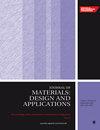Removal of impurities accumulated on the surface of nanosecond laser-treated Titanium
IF 2.5
4区 材料科学
Q3 MATERIALS SCIENCE, MULTIDISCIPLINARY
Proceedings of the Institution of Mechanical Engineers, Part L: Journal of Materials: Design and Applications
Pub Date : 2024-05-22
DOI:10.1177/14644207241249895
引用次数: 0
Abstract
Due to the efficient utilization of thermal energy by the interfacial evaporation, more and more research is attempting to apply it to concentrate wastewater. However, photothermal materials tend to accumulate impurities on their surface during the concentration process, which affects their subsequent use and requires periodic removal. Acidic, ultrasonic, and heated water cleansing methods are used to remove impurities from the surface of nanosecond laser-treated titanium (NLTI). Both acidic and ultrasonic cleansing are effective in removing impurities without damaging the micro-nano structure on the surface. After undergoing acidic cleansing, NLTI exhibits an evaporation rate of 1.25 kg/m2/h, which is 86.2% of its original performance. Similarly, after ultrasonic cleansing, NLTI exhibits an evaporation rate of 1.24 kg/m2/h, which is 82.6% of its original performance. It is worth noting that even after undergoing multiple cleansing cycles, both acidic, and ultrasonic cleansing maintain stable evaporation rates. Additionally, these cleaning methods are straightforward to implement, offering safeguard for the engineering application of solar thermal materials.清除纳秒激光处理钛表面积累的杂质
由于界面蒸发能有效利用热能,越来越多的研究尝试将其用于浓缩废水。然而,光热材料在浓缩过程中容易在其表面积累杂质,影响后续使用,需要定期清除。酸性、超声波和加热水清洗方法可用于清除纳秒激光处理钛(NLTI)表面的杂质。酸性清洗和超声波清洗都能有效去除杂质,且不会破坏表面的微纳米结构。经过酸性清洗后,NLTI 的蒸发率为 1.25 kg/m2/h,是其原始性能的 86.2%。同样,经过超声波清洁后,NLTI 的蒸发率为 1.24 kg/m2/h,是其原有性能的 82.6%。值得注意的是,即使经过多次清洗,酸性清洗和超声波清洗都能保持稳定的蒸发率。此外,这些清洗方法简单易行,为太阳能热材料的工程应用提供了保障。
本文章由计算机程序翻译,如有差异,请以英文原文为准。
求助全文
约1分钟内获得全文
求助全文
来源期刊

CiteScore
4.70
自引率
8.30%
发文量
166
审稿时长
3 months
期刊介绍:
The Journal of Materials: Design and Applications covers the usage and design of materials for application in an engineering context. The materials covered include metals, ceramics, and composites, as well as engineering polymers.
"The Journal of Materials Design and Applications is dedicated to publishing papers of the highest quality, in a timely fashion, covering a variety of important areas in materials technology. The Journal''s publishers have a wealth of publishing expertise and ensure that authors are given exemplary service. Every attention is given to publishing the papers as quickly as possible. The Journal has an excellent international reputation, with a corresponding international Editorial Board from a large number of different materials areas and disciplines advising the Editor." Professor Bill Banks - University of Strathclyde, UK
This journal is a member of the Committee on Publication Ethics (COPE).
 求助内容:
求助内容: 应助结果提醒方式:
应助结果提醒方式:


